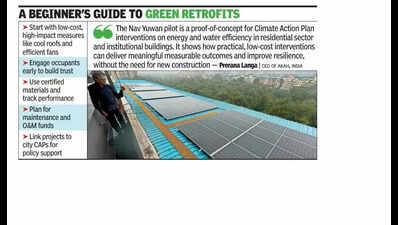Rahim Karovalia halts briefly between the two floors of a building in Mira Road to demonstrate the small wonder above us: A motion-sensor dimmable tubelight. As we approach it, its pale glow intensifies and lights up the landing. Karovalia’s face lights up too as he motions to it, for this seemingly unremarkable electrical fixture has helped reduce the monthly electricity bill of his housing society by 65%.“Our electricity bill, which was previously around Rs 52,000, is now Rs 18,000,” says Karovalia, 52, a managing committee member of Nav Yuwan Housing Society, a complex of 280 flats in Sector 4 of Mira Road (East), comprising of 1RK (400 sq ft) and 1 BHKs (580 sq ft) apartments.In Oct last year, a range of energy- and water-saving measures were implemented in this community. These included the installation of 150 motion-sensor lights in the buildings’ corridors, lift lobbies and staircases; 14 high-efficiency floodlights mounted in the parking bay; a 44-kWp solar photovoltaic system set up on the terraces to power these upgrades; and a kitchen garden to promote urban greening. A composting unit is in the pipeline to feed the garden and support waste management.Nav Yuwan’s home improvement solutions are part of a pilot designed and implemented by the nonprofit Aga Khan Agency for Habitat (AKAH), which aims to demonstrate that existing buildings can significantly reduce energy and water use, as well as emissions, through green retrofitting. This process involves upgrading or modifying buildings to improve sustainability and reduce their environmental footprint.At Nav Yuwan, the impact has been significant—an assessment reported 41% savings in energy, 35% in water, 59% in material efficiency, and a reduction in operational CO₂ emissions of 232.78 tCO₂/year. These achievements have earned the society a badge of honour, making it the first in Asia to receive the EDGE Advanced green building certification (in March this year) for meeting global benchmarks in emissions reduction and energy efficiency. Excellence in Design for Greater Efficiencies, or EDGE, is an international green building certification system developed by the International Finance Corporation, a member of the World Bank Group.“We are very proud of the certification,” says Karovalia, “It demonstrates our efforts at sustainability to residents, vendors and the municipal corporation. It will, no doubt, also increase the value of our flats.”Beyond its immediate benefits to residents, the certification is significant because it positions the housing society as a successful model for green retrofitting. Nav Yuwan is not a newly-built development based on sustainable principles, but a 30-year-old housing complex retrofitted with modern materials and technologies to enhance its sustainability. The project’s demonstrated efficiencies prove that older buildings can be upgraded to reduce climate-harming emissions—without the need for demolition or new construction—thereby positioning retrofitting as an effective climate solution. A study by the US-based nonprofit Rocky Mountain Institute (RMI) found that retrofitting an existing building produces 50–70% less carbon emissions than constructing a new one from the ground up.“Green retrofits improve thermal comfort, lower energy demand, reduce greenhouse gas emissions, and extend the life of existing buildings,” says Prerana Langa, CEO of AKAH, India. “The Nav Yuwan pilot is a proof-of-concept for Climate Action Plan interventions on energy and water efficiency in residential sector and institutional buildings. It shows how practical, low-cost interventions can deliver meaningful measurable outcomes and improve resilience, without the need for new construction.“The Nav Yuwan model aligns seamlessly with the Mira Bhayandar Climate Action Plan (MB CAP) 2024-2050—a joint initiative by the Mira Bhayandar Municipal Corporation and AKAH, launched in Jan this year—which targets a 36% reduction in emissions by 2047 through a focus on heat resilience and low-carbon housing. In 2023, Mira Bhayandar’s residential sector accounted for 62% of the city’s electricity consumption and 40.5% of its energy sector emissions.Nav Yuwan’s retrofit has, therefore, prioritised energy-saving measures. These have not only been implemented in common areas, but in homes too. Each of the 280 flats at Nav Yuwan has been equipped with brushless DC (BLDC) fans that consume less than half the power of older models and generate lower electricity bills. “We did not realise that small changes can have such big impacts,” says Parvin Jasani, 64, whose monthly electricity bill has reduced from Rs 1,800 to Rs 1,000. “We are now able to save more money.” Her husband, Bahadur, 63, notes that most people don’t view their households as contributors to climate change—and as a result, don’t know what changes to make to reduce their impact. “Awareness of what people can do at the household level needs to be built,” he says.AKAH built this understanding systematically through awareness and capacity-building programmes that combined technical guidance—such as the benefits of energy-efficient appliances—with behaviour change tips, like choosing bucket baths over showers and using air conditioners more efficiently. “We always believed that the longer you use an appliance the more cost-effective it is. We did not realise that an old, energy-draining appliance can actually be more costly in the long run. Neither were we aware of the benefits of high-starred appliances,” says Anisha Maknojiya, 48. This is why retrofits go hand-in-hand with awareness building.Word about the retrofit and its payoff has spread to other housing societies and several are keen to replicate the model, which costs Nav Yuwan Rs 17,500 per household unit. AKAH itself has retrofitted three municipal schools in Mira Bhayandar..Langa believes the model is easily scalable “through policy inclusion in city CAPs, financing via CSR and municipal budgets, SHG/community funds for operation and maintenance, and bulk procurement to reduce costs.”“By linking retrofits to routine maintenance cycles, municipal budgets, and commercial investment returns, the model shifts from one-off projects to mainstream adoption,” she says, “This makes structural scale-up viable across Mira Bhayandar and replicable in other cities.”










